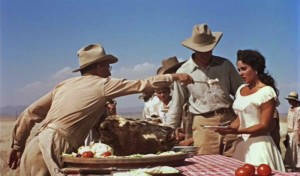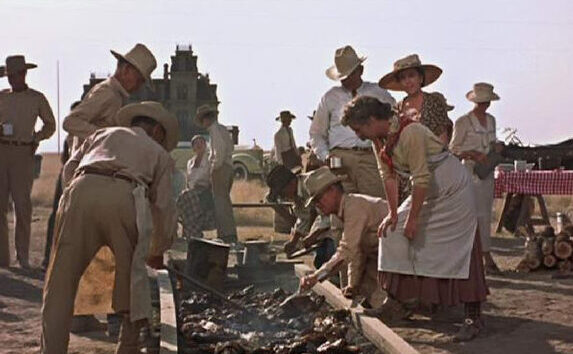Stevens’ barbacoa picnic in Giant is sure-fire-cinema. When Virginia-born-and-bred Leslie Lynnton attends her first Texas picnic, she faints.
Barbacoa is an acquired taste at a picnic or elsewhere. It may be delicious, but it is not for the squeamish. Leslie realizes she is not looking at an ordinary picnic clambake when three vaqueros lift the firepit’s burlap sacks. Instead, she sees a pit-roasted-skinned calf’s head with eyes in the sockets, tongue hanging out of an open mouth, teeth grinning, and collops of roast meat hanging from cheeks and jowls.

Leslie Benedict’s husband Bick kindly explains this is “the real Spanish-Mexican barbecue, Leslie. They despise what we Americans call barbecue—meat roasted over coals. This pit-cooking is the real Mexican barbacoa. That’s where we get the word.”
Leslie replies, “I don’t think I’m really hungry.” Then she faints in Bick’s arms.
See George Stevens. Giant (1956). The screenplay by Fred Guiol and Ivan Moffat is based on Edna Ferber’s novel (1952), Edna Ferber. Giant. Garden City, NY: Doubleday & Co., 1952. Steaming: https://archive.org/details/1956giant
* Ferber gives a recipe in her novel Giant. The calf’s hair and skin are removed, but not the tongue or teeth. There is no mention of horns. Contemporary South Texas/Norteño-style barbacoa differs from barbecue because it is pit-cooked (en pozo) and not smoked or indirectly. The primary ingredient is a whole calf’s or cow’s head wrapped in burlap and buried in the coals for 12-18 hours.

